Misc
HORROR 101: What is The New French Extremity Movement?
What is New French Extremity? The term New French Extremity originated in film journalist James Quandt’s article “Flesh & Blood: Sex and Violence in Recent French Cinema”. The bulk of the article addresses a rash of more violent films that were coming out of French cinema in the late 90s and early 2000s; the article sites Bruno Dumont’s 2003 art film Twentynine Palms as inciting the criticism, seeing it as the latest in a long line of, to him, unimpressive French films at the turning point of a century.

Welcome back to Horror 101, a series of articles where we explain horror movie legends and their lore. For beginners, the confused, or just those who need a refresher, these articles are for you.
It is certainly ironic to be close-minded as a horror fan. What do you mean you’ll watch fifteen terribly made movies in a week but then turn your nose up at something 20 minutes longer than your usual runtime? (That one was aimed at me, so if you caught a stray, apologia).
But, I’ve always been particularly averse to one grouping of films: New French Extremity, a genre whose name came from an article deriding the very notion of it. In more recent years, I’ve grown some appreciation for its offerings, though, as I’ve come to understand the commentary it has to share. It’s a genre pockmarked by bleak cinematic landscapes, painted with the pains of human suffering and grotesqueries to reflect the horrors of the real world. A genre that often delves into the surreal, wading knee-high through depravity to get there.
…Assuming you can call it a genre.
Like German Expressionism, or Dadaism, it’s a style with some major tenets, but no concrete trappings; debated and shaped by its watchers, and now brought to you here. It’s sometimes hard to grasp, but today’s article will try its hardest to answer the question…
WHAT IS NEW FRENCH EXTREMITY?
The term New French Extremity originated in film journalist James Quandt’s article “Flesh & Blood: Sex and Violence in Recent French Cinema”. The bulk of the article addresses a rash of more violent films that were coming out of French cinema in the late 90s and early 2000s; the article sites Bruno Dumont’s 2003 art film Twentynine Palms as inciting the criticism, seeing it as the latest in a long line of, to him, unimpressive French films at the turning point of a century.
Quandt generally writes them off, indicating that they utilize their debauchery as a blunt tool in a clumsy attempt to evoke some sort of philosophical or political message about the human condition, as opposed to the artistic movements of centuries prior like the French Decadent Movement and Dadaism that inspired it. Ironically, the term New French Extremity erupted from this article as the main takeaway for film scholars and critics, because Quandt caps off the article by saying that the grouping of films are too varied in their vision to be considered a proper genre:
The New French Extremity sometimes looks like a latter-day version of the hussards, those Céline-loving, right-wing anarchists of the ’50s determined to rock the pieties of bourgeois culture; but for all their connections (shared actors, screenwriters, etc.), the recent provocateurs are too disparate in purpose and vision to be classified as a movement. […] it appears to be the last gasp of Gallic libertinism.
And so, New French Extremity was minted as a piece of the cinematic lexicon. Jargon meant to describe not only grotesque thriller and horror films coming out of France from the 90s onward, but films whose whole cinematography (both by visuals and by narrative) is rooted in being transgressive. No matter how horrible you think a concept is, New French Extreme will depict it, and no matter how sacred you think something is, expect it to be trampled on with some extremely profane filmmaking. It’s about being so grotesque that they evoke raw and pure disgust, often to reflect the film’s themes or philosophical ideas.
Then, you might ask…
WHAT IS THE DIFFERENCE BETWEEN NEW FRENCH EXTREMITY AND SPLATTER FILMS?
Surely, films like Saw, Hostel, and Human Centipede have political messages underpinned by their violence. And yes, the Saw franchise in particular can at turns be very meanspirited and violent while being bluntly political; it is what I’d call the most politically American horror film series of all time, and its traps and the major bodily dysfunction they cause are a big part of that.
But in the end, it’s not being an American film that separates it from the genre, as even if it were a French film it wouldn’t fit either. Part of the horror of New French Extreme films is how the violence is presented; it is served as real, raw, and uncut as possible. It is unflinchingly (and unhappily) violent, and grounded in a level of uncomfortable reality. So, there goes another tenet of the movement: it has to crank up the meanspirited energy in its violence, and it can’t really be “fun” in how it displays its extremity.
WHO ARE THE DIRECTORS OF THE NEW FRENCH EXTREMITY MOVEMENT?
As critical as Quandt was of the idea, he did provide a very handy list of names to focus on as the most prominent voices of the movement:
“François Ozon, Gaspar Noé, Catherine Breillat, Philippe Grandrieux—and now, alas, [Bruno] Dumont”.
Names missing from that list, but which crop up later in the article and in the scene in general include Alexandre Aja (director of High Tension), Virginie Despentes (the mind behind the very controversial Baise-moi), Alexandre Bustillo & Julien Maury (the duo behind Inside and this years The Soul Eater), and Pascal Laugier (of Martyrs and Incident in a Ghostland fame). And though Xavier Gens was a bit late to the party with his 2007 film Frontier(s), he is an important director in terms of where the movement went and where it’s going with its politics. This isn’t a comprehensive list, but a good starting point for you if you’re interested in the genre.
WHO IS THE MOST INFLUENTIAL NEW FRENCH EXTREMITY DIRECTOR?
The short answer? Michael Haneke. The long answer? Technically, Haneke popularized the use of transgressive elements to shock and disquiet the audience among his contemporaries. Still, Gaspar Noé is the genre codifier and the most dominant voice in the space creatively.
Despite the extreme nature of films like Funny Games and The Seventh Continent (both brutal and genuinely terrifying), I personally find myself in the camp that his movies are not New French Extreme. We can debate the limits of how messed up something has to be before it’s considered extreme until the cows come home. But the fact is, if you put Haneke’s work alongside all of the films I’ve listed above in the previous segment, he would be the odd man out. He is, simply put, considerably more restrained in terms of showing gore and sexual violence, and the majority of his films’ horror and anxiety come from psychological aspects rather than physical consequences.
The material world is the battleground of the New French Extreme, and the nauseating nature of the films is the tool that Quandt named as the hallmark of the movement. With that in mind, I believe that Gaspar Noé, instead, should be considered the godfather of the genre. Given his films are the most well-known and commercially successful of the New French Extreme “movement”, he is more than worthy of the title; not to mention, he’s the most extreme in all regards. I would consider Irreversible’s directing and presentation to be the peak of the New French Extreme, since its nausea-inducing and sickening content comes with plenty of disorienting directing and editing; and for people with better sound setups than mine, you’ll find the little sound design trick that Noé placed in the film to make it as disturbing as possible.
WHAT IS THE MEANING OF NEW FRENCH EXTREMITY?
A question that is much less definitional, and much more philosophical. Why the bleak landscapes? Why the hopeless endings? Why so much violence against women, especially THAT kind of violence? And there is no clear answer, as every filmmaker has a different motivation. However, there is an undeniably political slant running through most of these movies that can all generally be applied to the rise of the right-wing and alt-right in French politics from the 1990s onward.
Film scholars like Alice Haylett Bryan and Marc Olivier have pointed to films like Inside, Sheitan, and Frontiers as coinciding with and commentating on the rise of politicians like Nicolas Sarkozy, politicians running on strong anti-immigration platforms and blaming the immigrant populations of France for its ills like the 2005 riots. Though it is less easy to see on the surface level, the Mademoiselle of Martyrs and her secret society are a group of wealthy, white French aristocrats who find purpose through the suffering of others, depicted as the impoverished and WOC; they even describe the process of torturing their martyrs as something they do “systematically”, akin to the policies of a government.
Like the trend of the nuclear monster reflecting our Cold War anxieties in the 50s and 60s, and the spike of home invasion films that took place in the 70s, New French Extreme directors have political engines built into their movies. The shocking parts of New French Extremity punctuate what many of these films are supposed to be: countercultural art meant to attack and depict the dangerous political ideologies that spends the lifeblood and livelihood of underserviced people as currency; ideologies that could very well pose a threat to the existence of a democratic France itself.
New French Extremity’s horrifying sights are not only made effective through the verisimilitude of their directing and production; they are made to remind you of the world’s much more realistic terrors, here right now and possibly yet to come.
DO YOU HAVE NEW FRENCH EXTREMITY RECOMMENDATIONS?
So, now for your required reading from this lecture.
Needless to say, all of the films mentioned in this article bear a massive and profoundly long list of trigger warnings (seriously), primarily for their intense violence, depictions of sexual violence, and depictions of pretty much every terrible thing you can imagine. Please make sure to do your research before watching any of these, and don’t skimp on the self care.
Martyrs (2008) has some of my favorite reveals in any horror movie, and an unforgettable ending you won’t want spoiled, so watch this one first. High Tension is a favorite of many Horror Press readers and writers for a reason. It’s an unrelenting, pulse-pounding film that earns its controversial reputation, and you don’t really feel safe until it’s over (if that). Trouble Every Day gets a lot of flak from Quandt in his original article (what doesn’t?), but I went in blind and was completely caught off guard by what the movie turns into, so avoid any spoilers if you want to see something interesting. Sheitan is a head trip of a film, with recurring face-of-the-genre Vincent Cassel cranking up the madness dial on his performance to an 11. Calvaire, likewise, has a very demented villain on par with the main antagonist of Inside, so they would make for a very interesting double feature if you can stomach two at a time. And while I said Haneke is not New French Extreme, if you want something a little quieter but with an ending that will shake you to your core, I suggest watching The Seventh Continent.
That brings me to the one very big question I had writing this:
Should I even recommend Irreversible? It may be the one film that embodies New French Extremity the most, given how far it pushes the envelope. But do I like it?
No.
It personally is just too much for me. It’s bleak, horrific, it will disturb you entirely and might very well ruin your week, and I can’t stand to watch it. Which is the whole point, but there’s a limit to what I can tolerate. I find Noe is unflinching in his determination to make you run from the theatre and abandon the film altogether, especially in its most infamous and cruel sequence.
From a film history perspective, it is undeniably a piece that has carved itself into French cinema indelibly (for better and for worse), and if you want to plumb the depths of human horror, you’ll be hard-pressed to find as difficult of a watch. So, when you ask me, “Should I watch Irreversible?”, I can only meet you with one honest response: you can certainly try to.
Good luck with that, horror fan.
***
And that will be it for today’s Horror 101 lesson. See you in the next class and stay tuned to Horror Press’s social media feeds for more content on horror movies, television, and everything in between.
Misc
Our Halloween Giveaway Is Here!
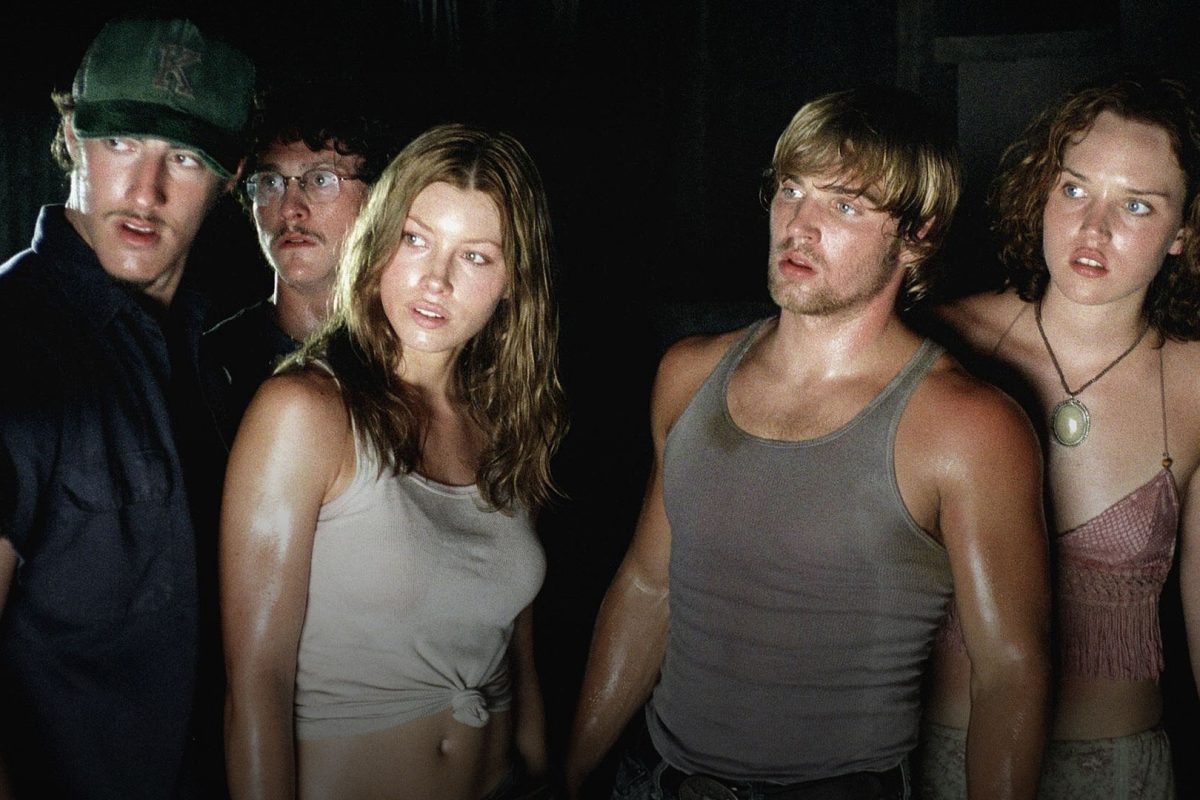
Enter Our Halloween Giveaway!
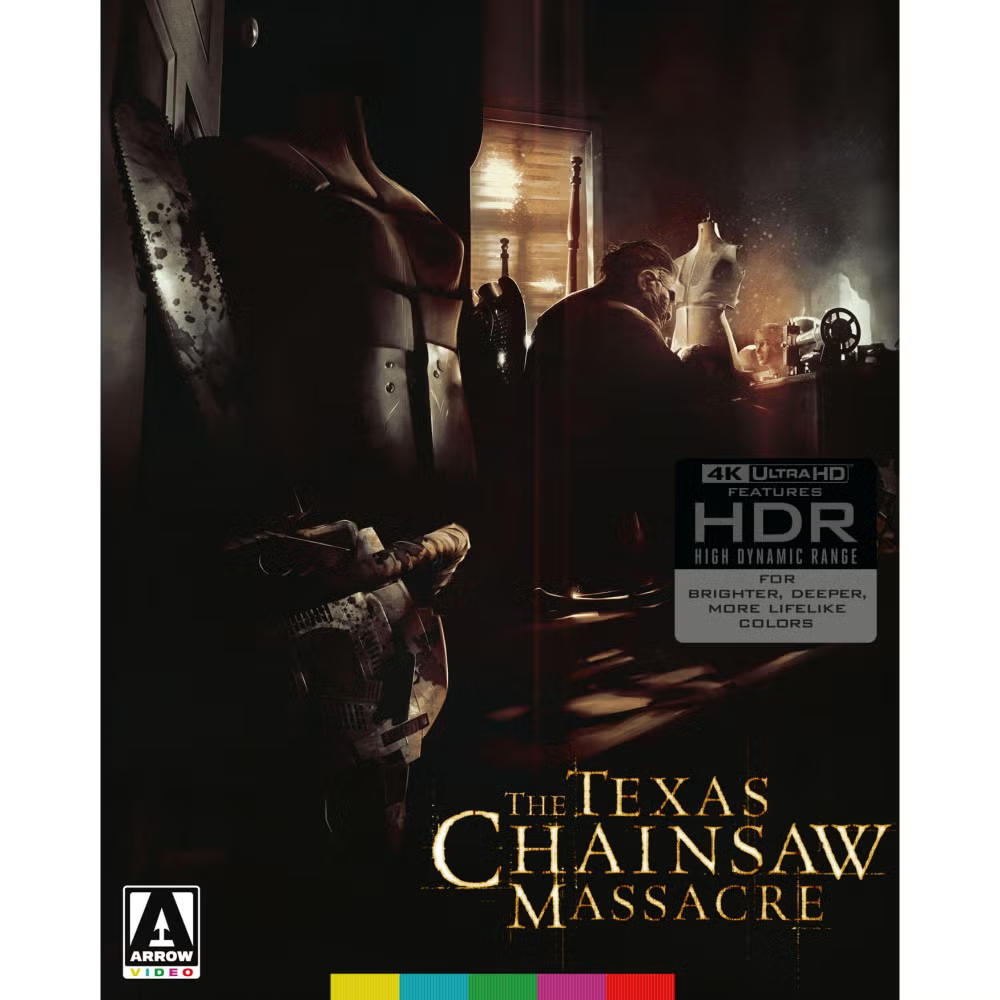
How to Enter:
Step 1. Make sure to FOLLOW US ON FACEBOOK AND JOIN OUR FACEBOOK GROUP!
Step 2. LIKE AND SHARE the giveaway post!
Step 3. This is the most important step, email us at contact@horrorpress.com with your FULL Facebook name (so we can verify you’re in the group) and who your favorite character is from the Texas Chainsaw franchise.
**Giveaway entries are limited to addresses in the United States.**
**All entries must be 18 or older to enter**
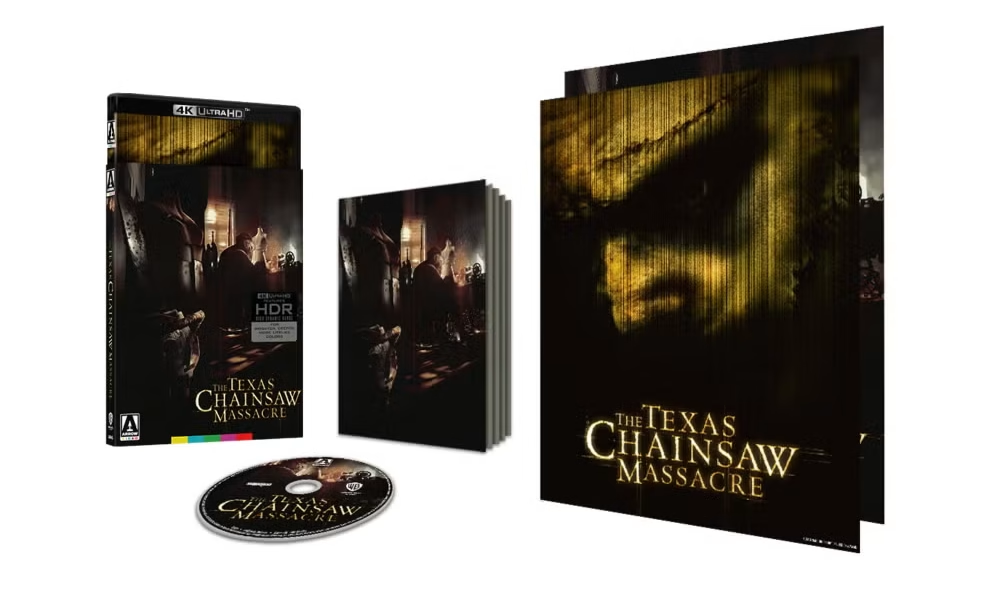
What You’ll Win
The Texas Chainsaw Massacre (2003) Limited Edition 4K UHD from Arrow Video
- 4K (2160p) Ultra HD Blu-ray presentation in Dolby Vision (HDR10 compatible)
- Original DTS-HD MA 7.1 and 5.1 surround audio and lossless stereo audio
- Optional English subtitles for the deaf and hard of hearing
- Brand new audio commentary with Dread Central co-founder Steve “Uncle Creepy” Barton and co-host of The Spooky Picture Show podcast Chris MacGibbon
- Archival audio commentary with director Marcus Nispel, producer Michael Bay, executive producers Brad Fuller and Andrew Form and New Line Cinema founder Robert Shaye
- Archival audio commentary with Marcus Nispel, director of photography Daniel Pearl, production designer Greg Blair, art director Scott Gallager, sound supervisor Trevor Jolly and composer Steve Jablonsky
- Archival audio commentary with Marcus Nispel, Michael Bay, writer Scott Kosar, Brad Fuller, Andrew Form and actors Jessica Biel, Erica Leerhsen, Eric Balfour Jonathan Tucker, Mike Vogel and Andrew Bryniarski
- Reimagining a Classic, a brand new interview with director Marcus Nispel
- Shadows of Yesteryear, a brand new interview with cinematographer Daniel Pearl
- The Lost Leatherface, a brand new interview with actor Brett Wagner
- Masks and Massacres, a brand new interview with makeup effects artist Scott Stoddard
- Chainsaw Symphony, a brand new interview with composer Steve Jablonsky
- Chainsaw Redux: Making A Massacre, a making-of documentary
- Ed Gein: The Ghoul of Plainfield, an in-depth look at the infamous killer who inspired the character of Leatherface
- Severed Parts, a look at the cutting room floor and some of the scenes excised from the final edit
- Deleted scenes including an alternate opening and ending
- Screen tests for Jessica Biel, Eric Balfour and Erica Leerhsen
- Behind-the-scenes featurette
- Cast and crew interviews
- Theatrical trailers and TV spots
- Concept art galleries
- Reversible sleeve featuring original and newly commissioned artwork by Aaron Lea
- Double-sided foldout poster featuring original and newly commissioned artwork by Aaron Lea
- Illustrated collector’s booklet featuring new writing on the film by Michael Gingold
Misc
NYCC 2025 Horror Highlights: A Sneak Peek at ‘The Lost Boys’ Musical, ‘Resident Evil: Requiem,’ and More!
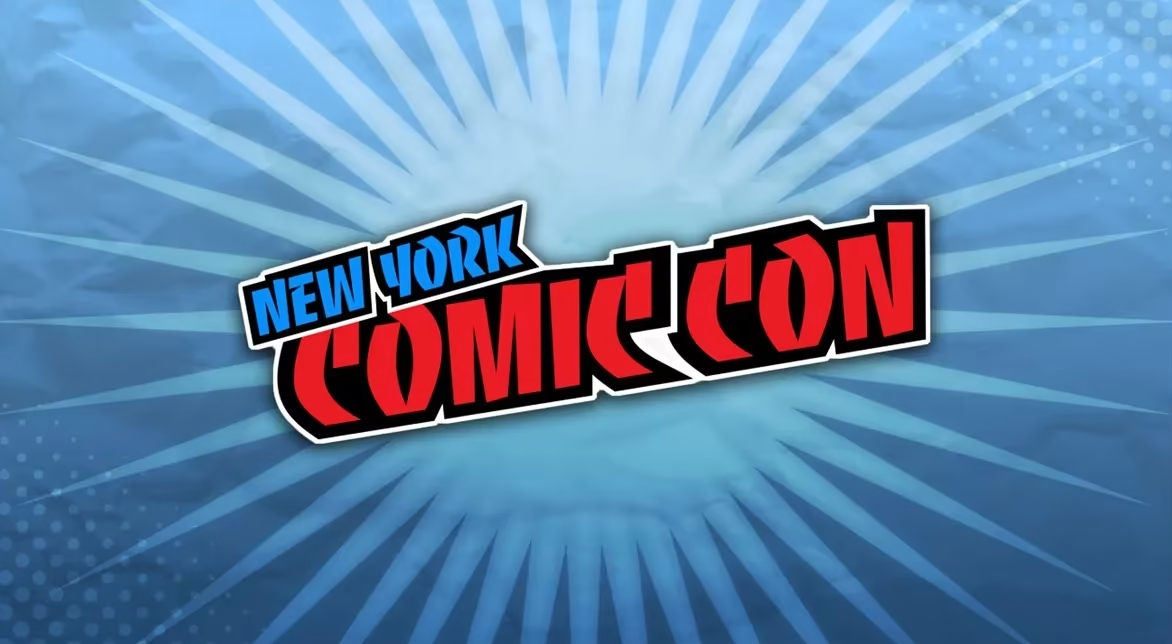
As soon as New York Comic Con announced that its 2025 theme would be “haunted,” I started lacing up my comfy shoes and making a beeline for the Javitz Center! Horror has always been represented at the con, but it felt fitting that it should play a central role in this year’s event at a time when the genre seems more popular than ever.
From beloved family-friendly properties like The Nightmare Before Christmas to pants-dampening titles like the upcoming Resident Evil: Requiem, horror appeared in countless shapes and forms. Here are all the best and scariest insights I gleaned from the show floor, panel rooms, and pop-ups of New York Comic Con 2025!
Our NYCC 2025 Horror Highlights
Resident Evil: Requiem Is Going to Test Your Bladder Strength
Full disclaimer: I’m not a gamer. I’m honestly pretty bad at games, which made my Resident Evil: Requiem play session all the more frightening because I was convinced that everyone around me would realize I’m a fraud. But with easy-to-grasp controls, even for a newb like me, the latest installment in the iconic horror franchise quickly sucked me in and left me on edge for entirely different reasons.
During my 30-minute session, I was introduced to FBI analyst Grace Ashcroft, Requiem’s central character. She swims to consciousness to find herself strapped upside down on a gurney with a needle in her arm, siphoning her blood. After Grace managed to free herself, the controls were handed over to me to explore the creepy facility through Grace’s eyes, looking for a fuse. Some spaces were bathed in red light; others were lit only by flickering bulbs that left me white-knuckling the controller, waiting for something to emerge from the shadows and swallow me whole, not helped by Grace’s anxious, stuttering breathing in my ear.
I took a moment to appreciate how detailed video games have become since my childhood experiences playing Evil Dead: Hail to the King on the original PlayStation (seriously, you can see the dust drifting in beams of light now?!), only for the sound of movement somewhere in the facility to yank me back to the present. I renewed my frantic search for the fuse, only to run blindly into a pitch-black room and encounter something enormous that dragged me into the darkness. Sorry, Grace!
You can find out what happens next when Resident Evil: Requiem releases for the PlayStation 5, Xbox Series X|S, PC, and Nintendo Switch 2 on February 27, 2026.
Megan Fox Is Among the New Cast Members in Five Nights at Freddy’s 2—And Blumhouse Hasn’t Given Up on Its Other m3gan Yet
Blumhouse made several announcements at their NYCC panel, most notably that Megan Fox (Jennifer’s Body) is voicing Toy Chica in director Emma Tammi’s highly anticipated sequel Five Nights at Freddy’s 2, coming to theaters on December 5. Other new additions to the cast include YouTuber Matthew Patrick, aka MatPat, who cameoed in the first movie and will voice Toy Bonnie, and Kellen Goff, who has voiced multiple characters in the game series and will now lend his pipes to Toy Freddy.
I’m interested in Five Nights at Freddy’s 2, not least because my best friend is terrified of the franchise and makes a wildly entertaining moviegoing companion—but I’m more interested in the future of another Blumhouse franchise, M3GAN. After the sequel underperformed, likely due in part to its hard genre pivot away from horror and into action territory, the future of the killer doll is uncertain. But in a special industry presentation on “The Business of Fear,” Jason Blum revealed that “we’re all working to keep M3GAN alive,” adding that Blumhouse is exploring other potential mediums before trying to resurrect her on film.
Does that mean a M3GAN video game might come our way in the future, or perhaps a TV series? I don’t know, but I have a feeling this isn’t the last we’ve seen of the silicone diva.
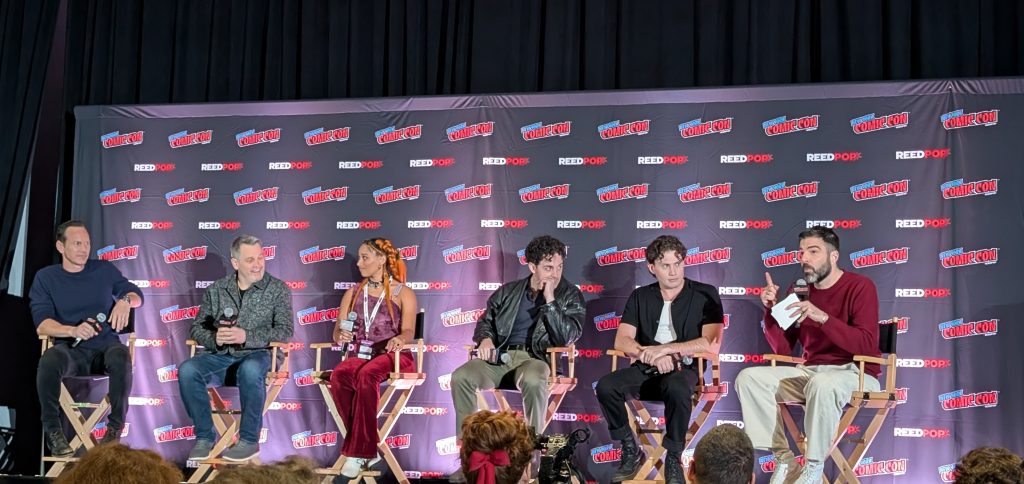
Photo taken by Samantha McLaren.
The Lost Boys: A New Musical Will Feature Flying Stunts and a Live Vampire Band
My queer heart is a sucker for musical adaptations of horror films I love, so you can be certain that I’ll be heading down to the Santa Carla Boulevard—aka Broadway’s Palace Theater—for The Lost Boys: A New Musical, which begins previews on March 27, 2026. At their NYCC panel, producer Patrick Wilson (The Conjuring franchise), director Michael Arden (Maybe Happy Ending), and cast members LJ Benet, Ali Louis Bourzgui, and Maria Wirries revealed why they feel Joel Schumacher’s 1987 classic translates so well to the stage, and what audiences can look forward to.
“There’s something that I see with both horror movies, musicals, and superhero movies—there’s an element of melodrama that’s really rewarding,” says Wilson, who began his career in musical theater and worked with Schumacher on the director’s 2004 film adaptation of The Phantom of the Opera. “Some people view it as camp, but there’s a reality of it being heightened that felt like this story cemented itself so much to being a musical.”
“They’re a biker gang, after all, and there’s a level of theatricality to that in and of itself,” says Arden. “Our biker gang also happens to play instruments.”
That’s right: the vampires will be playing instruments live on stage, which made casting twice as hard. Ali Louis Bourzgui, who plays David, the character portrayed by Kiefer Sutherland in the film, reveals that he plays guitar. And that wasn’t the only unusual request in the casting call: auditions included a flying test. (Presumably wires were involved, unless Arden has found himself a real cabal of vampires in his cast.)
Other highlights that fans can look forward to include killer music from one of Arden’s favorite bands, The Rescues. You can listen to the song “Have to Have You” right now, featuring instrumentals from Slash. The director also teases that many fan-favorite moments from the film will feature in some way in the musical, including the bridge scene and, yes, even the sexy saxophone guy.
Greg Nicotero’s Guts & Glory Marks a New Challenge for a Legend of the Business
If you like looking at gnarly practical effects in horror movies, chances are you’re familiar with Greg Nicotero’s work, whether you realize it or not. The legendary SFX artist has worked on everything from George Romero’s Day of the Dead and Sam Raimi’s Evil Dead II to Kill Bill and, more recently, The Walking Dead. The impressive extent of his resume was made clear at the panel “Shudder is Here to Scare the S*** Out of You,” in which almost any film mentioned by the other panelists was met by a small smile and a humble murmur of “worked on that” into the mic, often followed by a wild anecdote. Nicotero seems like the most interesting man in the world to grab a drink with, and his new horror competition show for Shudder—Guts & Glory—will let us see more of the man behind the makeup brush.
“Guts & Glory is one of the most fun times I’ve had on a show,” Nicotero says, teasing that the series is “part Sam Raimi, part Halloween Horror Nights, and part Survivor.”
In the six-episode first season, contestants are dropped into an Alabama swamp, where there’s an urban legend about an evil spirit. “One of the contestants gets possessed by the evil spirit, people start dying off, but in the meantime, they’re still competing and there’s a prize,” Nicotero explains.
Guts & Glory is effects-heavy, which was challenging to do in an unscripted series relying on real people’s real-time reactions. “You do a movie, you can cut and try it again,” Nicotero explains. “[This] was completely out of my wheelhouse and out of my comfort zone, but I’m really, really proud of it.”
Nicotero’s Creepshow was one of the first original shows to debut on Shudder, so he’s truly part of the DNA of the horror streamer, which celebrated its 10th anniversary this year. Guts & Glory premieres on October 14 as part of Shudder’s Season of Screams programming.
Horror Short The Littles Deserves the Big-Screen Feature Treatment
Some short films are perfectly suited to their bite-sized format, while others contain the seeds of something much bigger. At the New York Premiere of The Littles, a new short written and directed by American Horror Story producer Andrew Duplessie, I could immediately see the potential for the feature film that Duplessie hopes to make.
Equal parts charming and unsettling, The Littles stars M3GAN’s Violet McGraw as a little girl with a loose floorboard in her bedroom. One night, a scuffling sound and a crack of light between the boards lead the little girl to discover that her family isn’t alone in the house…
Duplessie says The Littles was inspired by his own experiences growing up in a creaky old house with a no-doubt overactive imagination. The short features creepy-cute stop-motion animation from Anthony Scott (The Nightmare Before Christmas), puppets by Katy Strutz (Guillermo del Toro’s Pinocchio), and some truly adorable miniature sets by Aiden Creates, all blended perfectly with the live-action scenes. Check it out if it’s playing at a festival near you, and watch this space for a (fingers-crossed) future feature!
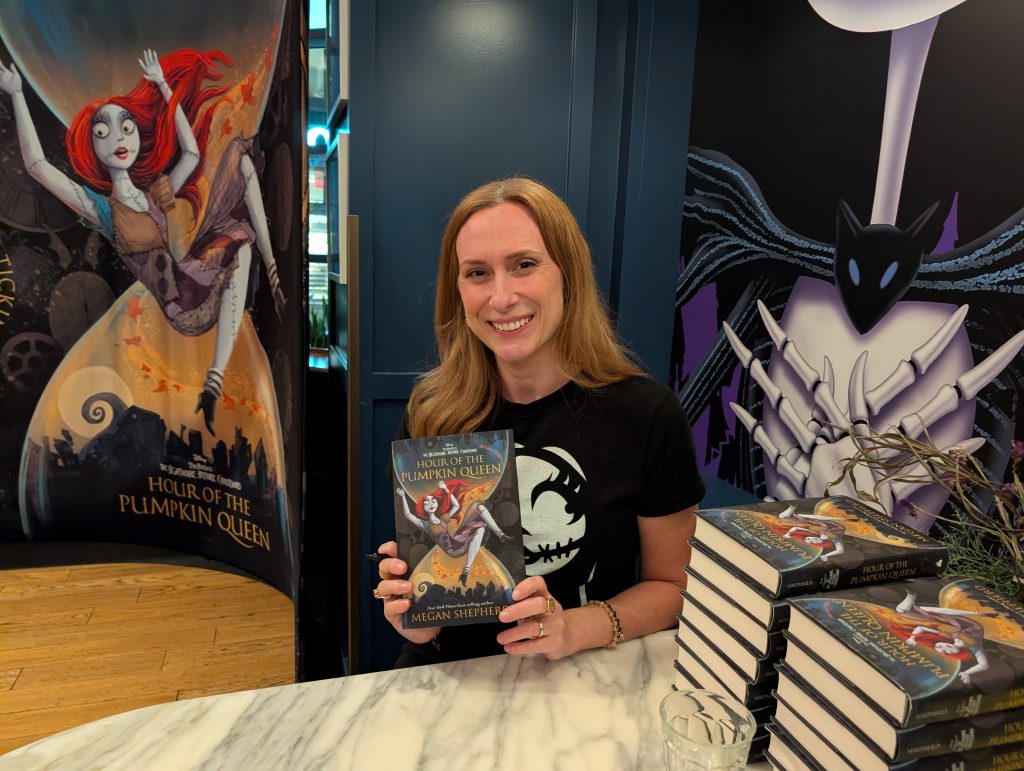
Photo taken by Samantha McLaren.
Disney Publishing’s New The Nightmare Before Christmas Tie-in Novel Welcomes Younger Fans into the Scary Fun
NYCC’s horror happenings weren’t all geared toward an adult audience. Disney Publishing took over Daily Provisions Manhattan West for a pop-up experience inspired by The Nightmare Before Christmas, featuring themed food and drinks like a delectable Pumpkin Potion coffee that I could honestly drink all season long.
At a media and creator event in the space, I took a look at the newly released Hour of the Pumpkin Queen from New York Times best-selling author Megan Shepherd, who also wrote the official novelization of The Nightmare Before Christmas for the film’s 30th anniversary in 2023. In this new tie-in novel, Sally and her rag doll apprentice, Luna, embark on a time-bending adventure to save Jack Skellington and Halloween Town after falling through a mysterious portal.
I was gifted a copy of the book by Disney, but all opinions are my own here. I’m looking forward to giving it a read during the inevitable Halloween hangover that takes place in November, before likely passing it on to my young nieces when they’re old enough. It’s a full novel, not a picture book, so definitely geared more toward a YA audience, but between the beautiful artwork on the cover and the seasonal theme, it might just be the perfect gift for the budding horror lover in your life.
That’s a wrap on New York Comic Con 2025! Be sure to bookmark Horror Press if you haven’t already so you never miss our coverage of conventions, festivals, and more.

























